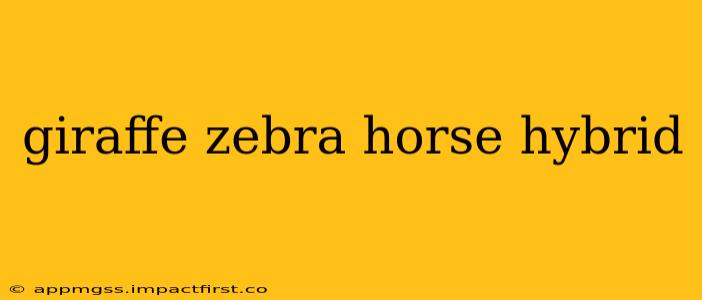The idea of a giraffe-zebra-horse hybrid conjures images of a fantastical creature, a blend of majestic height, striking stripes, and equine grace. While the thought is captivating, the reality is far more complex. Creating such a hybrid is biologically improbable, if not entirely impossible, due to significant genetic barriers. This article explores the scientific reasons behind this, addressing common questions surrounding interspecies breeding and the challenges involved in combining such distinct animals.
What are the genetic differences between giraffes, zebras, and horses?
Giraffes, zebras, and horses, while all mammals and ungulates (hoofed animals), belong to vastly different evolutionary lineages. Their genetic makeup is significantly different, making successful interspecies breeding extremely difficult. The number of chromosomes—the structures containing genetic information—varies greatly between these species. Incompatible chromosome numbers hinder the proper pairing and segregation of genetic material during meiosis, the cell division process that produces gametes (sperm and eggs). This incompatibility is a major obstacle to creating viable offspring.
Could a hybrid between two of these animals be possible?
While a triple hybrid is highly unlikely, hybrids between some pairs are theoretically possible, albeit extremely rare and often infertile. For example, zebras and horses can sometimes produce zebroids (a cross between a zebra and a horse, often called a zorse, zebrule, or zonkey depending on the specific zebra species). Similarly, hybrids between horses and donkeys (mules) are relatively common, though mules are typically sterile. However, even these pairings are successful only under specific circumstances, with the genetic compatibility being relatively higher than what would be found between a giraffe and the other two species. The genetic distance between giraffes and either zebras or horses is much greater, rendering successful hybridization exceptionally improbable.
Are there any known examples of successful giraffe hybrids?
No. There are no known successful examples of giraffe hybrids with any other species. Giraffes are highly specialized animals with unique adaptations, and their genetic distinctiveness significantly limits their ability to interbreed with other animals.
Why is it so difficult to create hybrids between different species?
Interspecies hybridization is challenging because of several factors:
- Genetic incompatibility: The fundamental difference in the genetic makeup of different species prevents successful fertilization and development of offspring. Genes don't always align or work together correctly across species boundaries.
- Chromosome number mismatch: As mentioned above, a difference in chromosome numbers disrupts the normal process of meiosis, resulting in non-viable gametes or embryos.
- Reproductive isolation: Evolutionary mechanisms often prevent different species from breeding successfully, even if they are closely related. This could involve behavioral differences, physical incompatibilities, or other reproductive barriers.
What about genetic engineering? Could that create a giraffe zebra horse hybrid?
While genetic engineering offers advanced techniques to manipulate genes, creating a viable giraffe-zebra-horse hybrid using current technology remains incredibly challenging, if not impossible. The complexity of coordinating the expression of multiple genomes from three different species during embryonic development is insurmountable with our present knowledge and technological capabilities.
In conclusion, while the concept of a giraffe-zebra-horse hybrid is visually appealing, the biological realities stand firmly against it. The substantial genetic differences between these animals create insurmountable barriers to successful interspecies breeding, making such a creature a product of fantasy rather than scientific possibility.
